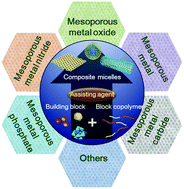当前位置:
X-MOL 学术
›
Chem. Soc. Rev.
›
论文详情
Our official English website, www.x-mol.net, welcomes your
feedback! (Note: you will need to create a separate account there.)
Recent advances in amphiphilic block copolymer templated mesoporous metal-based materials: assembly engineering and applications
Chemical Society Reviews ( IF 40.4 ) Pub Date : 2020/01/22 , DOI: 10.1039/c9cs00334g Yidong Zou 1, 2, 3, 4, 5 , Xinran Zhou 1, 2, 3, 4, 5 , Junhao Ma 1, 2, 3, 4, 5 , Xuanyu Yang 1, 2, 3, 4, 5 , Yonghui Deng 1, 2, 3, 4, 5
Chemical Society Reviews ( IF 40.4 ) Pub Date : 2020/01/22 , DOI: 10.1039/c9cs00334g Yidong Zou 1, 2, 3, 4, 5 , Xinran Zhou 1, 2, 3, 4, 5 , Junhao Ma 1, 2, 3, 4, 5 , Xuanyu Yang 1, 2, 3, 4, 5 , Yonghui Deng 1, 2, 3, 4, 5
Affiliation

|
Mesoporous metal-based materials (MMBMs) have received unprecedented attention in catalysis, sensing, and energy storage and conversion owing to their unique electronic structures, uniform mesopore size and high specific surface area. In the last decade, great progress has been made in the design and application of MMBMs; in particular, many novel assembly engineering methods and strategies based on amphiphilic block copolymers as structure-directing agents have also been developed for the “bottom-up” construction of a variety of MMBMs. Development of MMBMs is therefore of significant importance from both academic and practical points of view. In this review, we provide a systematic elaboration of the molecular assembly methods and strategies for MMBMs, such as tuning the driving force between amphiphilic block copolymers and various precursors (i.e., metal salts, nanoparticles/clusters and polyoxometalates) for pore characteristics and physicochemical properties. The structure–performance relationship of MMBMs (e.g., pore size, surface area, crystallinity and crystal structure) based on various spectroscopy analysis techniques and density functional theory (DFT) calculation is discussed and the influence of the surface/interfacial properties of MMBMs (e.g., active surfaces, heterojunctions, binding sites and acid–base properties) in various applications is also included. The prospect of accurately designing functional mesoporous materials and future research directions in the field of MMBMs is pointed out in this review, and it will open a new avenue for the inorganic–organic assembly in various fields.
中文翻译:

两亲性嵌段共聚物模板介孔金属基材料的最新进展:组装工程与应用
介孔金属基材料(MMBMs)由于其独特的电子结构,均一的介孔尺寸和高的比表面积,在催化,传感以及能量存储和转化方面受到了前所未有的关注。在过去的十年中,MMBM的设计和应用取得了巨大的进步。特别是,还开发了许多基于两亲性嵌段共聚物作为结构导向剂的新颖组装工程方法和策略,用于“自下而上”构造各种MMBM。因此,从学术和实践的角度来看,MMBM的开发都具有重要意义。在这篇综述中,我们对MMBM的分子组装方法和策略进行了系统的阐述,例如调整两亲嵌段共聚物和各种前体之间的驱动力((例如金属盐,纳米粒子/团簇和多金属氧酸盐),以提供孔隙特征和理化特性。MMBMs(的结构-性能关系É。克基于各种能谱分析技术和密度泛函理论。,孔尺寸,表面积,结晶度和晶体结构)(DFT)计算进行了讨论和的表面的影响/界面特性MMBMs(é。克也包括各种应用中的活性表面,异质结,结合位点和酸碱性质)。这篇综述指出了在MMBMs领域中准确设计功能性介孔材料的前景和未来的研究方向,它将为各个领域的无机-有机组装开辟新的途径。
更新日期:2020-02-24
中文翻译:

两亲性嵌段共聚物模板介孔金属基材料的最新进展:组装工程与应用
介孔金属基材料(MMBMs)由于其独特的电子结构,均一的介孔尺寸和高的比表面积,在催化,传感以及能量存储和转化方面受到了前所未有的关注。在过去的十年中,MMBM的设计和应用取得了巨大的进步。特别是,还开发了许多基于两亲性嵌段共聚物作为结构导向剂的新颖组装工程方法和策略,用于“自下而上”构造各种MMBM。因此,从学术和实践的角度来看,MMBM的开发都具有重要意义。在这篇综述中,我们对MMBM的分子组装方法和策略进行了系统的阐述,例如调整两亲嵌段共聚物和各种前体之间的驱动力((例如金属盐,纳米粒子/团簇和多金属氧酸盐),以提供孔隙特征和理化特性。MMBMs(的结构-性能关系É。克基于各种能谱分析技术和密度泛函理论。,孔尺寸,表面积,结晶度和晶体结构)(DFT)计算进行了讨论和的表面的影响/界面特性MMBMs(é。克也包括各种应用中的活性表面,异质结,结合位点和酸碱性质)。这篇综述指出了在MMBMs领域中准确设计功能性介孔材料的前景和未来的研究方向,它将为各个领域的无机-有机组装开辟新的途径。











































 京公网安备 11010802027423号
京公网安备 11010802027423号